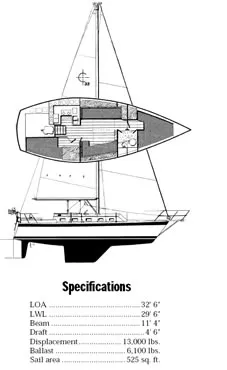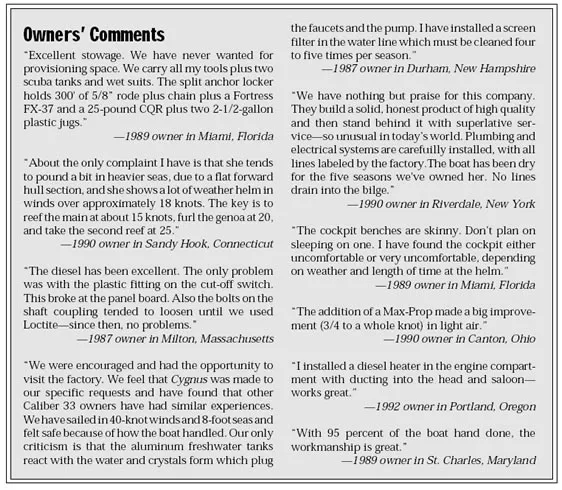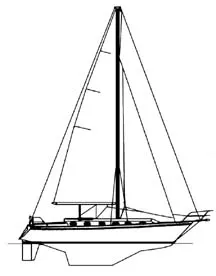
When the McCreary brothers (Michael, a naval architect, and George, a business major) got out of college, they built a boat in their garage. The next year, 1980, they formed a company and introduced a snappy 28-foot performance cruiser. In 1985, in the midst of boatbuilding’s grimmest times, they opened a plant and launched the Caliber 33.
Now Caliber offers a four-boat line, and its newest boat is a 47-foot “Long Range Cruiser.” The company’s business philosophy begins, “though no longer a backyard operation, we still believe that smaller is better.” While we have to wonder how their progression from 28 to 47 feet bears that out, Caliber’s position, practices and products all reflect the brothers’ brand of “small is beautiful.” Neither volume nor custom builders, they have staked out a somewhat unique piece of the waterfront.
The 33 was discontinued prior to 1990 and fewer than 70 were sold. Still, it was large in building Caliber’s reputation and identity. She is a peculiar blend of tradition and innovation, of security and performance, of practicality and pizzazz. All of the owners we heard from were “satisfied.” One called the 33 his favorite boat over six decades of sailing. The brothers received very good ratings, too, for listening to owners, dealing with problems and refining the boats.
The Design
Halsey Herreshoff once let slip the family’s secret, that Nathanael Herreshoff drew the masterstroke stem of the classic New York 40 “using a straightedge.” It looks like many of the Caliber’s lines were drawn the same way. The sheerline, house crown, house edge and cockpit coamings are, in designer McCreary’s profile drawing and sail plan, dead straight. The real boat, however, is not as angular as the blueprint. Trim, accents, curved toe-rails, stripes and refraction all bend and soften those knife-edges; the boat has a “sharp” look and (because most sailboats depend on fair curves for their appeal) the 33 is distinctive. Its bowsprit confuses the line of the stem, the stern is a bit too upright to be sexy, house and coaming are a touch blocky, but she gets second looks.
What sets the Caliber 33 apart from the smallcruiser crowd, though, is its stability. Depending on which brochure you believe, the displacement is variously reported as 11,400 pounds and 13,000 pounds. Same with ballast: 5,500 or 6,100 pounds of internal lead. For a well-above-average ballast/displacement ratio of about 48 per cent, it should be stiff. Low deadrise angles in the way of the keel, firm bilges and sections aft that are relatively flat add form stability.
Several years ago, we told George McCreary we’d like to test sail one of his boats. He declined. In the April 1996 issue, we asked for Caliber 33 owners to volunteer taking a PS editor sailing. Many responded, for which we are grateful. We ended up going out with Allan Barry, owner of a 1987 model in Marion, Massachusetts.

Under single-reefed main and genoa rolled-in one third, we were hard-pressed to heel her 20 degrees on the wind in 20 knots of true breeze. Our test model had the standard draft of 4′ 6″; a shoal draft model with 4′ 0″ draft and 500 pounds more ballast was offered.
Michael McCreary arranged the other elements of the design—a somewhat tall rig, smoothly modeled waterlines and a fairly long sailing length to minimize wetted surface—to make the 33 a rewarding boat to sail. Still, his first priorities seem to have been “big boat” feel and motion, a large interior and notable stability. That he managed this and still kept the displacement/length ratio at 198 (or 226, again depending on displacement) helps explain why so many cruising owners report satisfaction with her all-round performance. However, its medium-sized sailplan coupled with the parasitic drag of a big skeg/ rudder assembly and big keel, plus its overall heft, make light air a weak point.

Construction
The 33 was among the quietest boats we’ve sailed. In 5′ Buzzard’s Bay slop, the creaks and groans that can come with torquing and pounding in a seaway were absent. Caliber glasses the bulkheads and furniture to the solid-glass hull (as opposed to employing an interior “pan”). That is no automatic assurance of soundness; the precision of fit and bedding plus the care and materials that go into the glassing are all variable, but our 10-year-old test boat seemed well made. Caliber calls for double taping at all points and quadruple taping of structural bulkheads.
The fiberglass deck is cored with 3″ squares of plywood. Where most builders today use balsa, sometimes employing plywood for areas where compression is a concern (such as under hardware), the Caliber 33 has plywood throughout. It’s heavier than balsa and if it gets wet (hardware bedding wears out), localized delamination would be a likely consequence.
The McCrearys have trademarked their hull-deck joint. The “Quad-Seal” joint gets its name from the four separate seals against water penetration incorporated in the process. Most interesting, we felt, was the “gasket” formed by a ring of copolymer tape around the inboard end of the joint between hull and deck flanges. George McCreary explained that the tape forms a seal when hull and deck are joined. The remainder of the space between the hull and deck parts is sealed with 3M 5200. The joint is capped with an aluminum toe-rail (through-bolted on 6″ centers), and faced with a rubrail (stainless steel with cushioned rubber backing.) The tape gasket forces the sealant outboard, into the joint, rather than letting it escape into the boat. Caliber uses carriage bolts that fit square holes in the toerail so that tightening the bolts won’t cause them to turn and disrupt the seal. There are simpler, quicker ways, but George McCreary said, “We almost never get leaks, and when we do it’s usually from deck hardware.” Only one Caliber owner wrote about a leak, and it was traced to a stanchion base.
Caliber uses large, closely-spaced floor timbers; over-sized standing rigging and spar section; chainplates bonded with extra fiberglass; extra glass in the way of the engine beds and shaft log; stainless propeller and rudder shafts; steel rudder backbone, and cast bronze rudder shaft stuffing box.
Our owner was surprised and distrubed when, shortly after he took delivery, his anchor platform/ bowsprit, splintered in a heavy head sea. “We realized that it was too light,” said McCreary, “so we made the platform heavier, cut relieving slits in it, and went from schedule 80 to schedule 160 pipe for the support structure. We also used to weld the base in place. We changed it to a bolt-on nose piece, which made it much easier to repair.”
Interior
When the 33 appeared, making a “stateroom” by enclosing an over-sized quarter berth (to starboard) with a bi-fold partition was something of an innovation. Owners say that it has worked well, “a bit cozfor two,” a fine sea berth, and an appreciated “catch all” underway. One owner put a hand rail next to the folded doors because people grabbed the doors so often negotiating the companionway.
The companionway is broad, wider at the top than the bottom, and has four wide, gradually-spaced steps. Without a full bridge deck, getting up and down and fitting through are very easy. A rail to port (to prevent lurching into the galley) would make it even more secure. To blue-water purists, the opening might seem overly large. McCreary says the companionway boards lock in place, which is advised in heavy weather.
The galley is well-sited and efficient; stowage received high marks from owners. The owners of our test boat also customized utensil stowage with cutouts for their own pots and pans. It’s good to see a back-up foot pump for freshwater (70-gallon tank capacity) and seawater. Counter space extends beneath the wrap-around cabinets. Near the companionway and served by a small overhead hatch and porthole, the galley is well ventilated.
The fold-up table opens up the saloon (6′ 3″ headroom), though one owner reported having to beef up its bulkhead hardware.
Wood and white overheads, teak panels and trim, a teak & holly sole…the 33’s interior is traditional. It avoids “teakiness” with woods chosen from the bright side and ample natural light but is more conservative than memorable.
All non-cosmetic fiberglass used to be painted brown, but the owners of our test boat convinced the McCrearys to lighten up with white.
The navigation station could be bigger. Perhaps as a trade-off, the head is quite large. You can enter from either the saloon or forward cabin without disturbing the other space. The V-berth is 7′ long, but the taper forward (for foot room) restricts the useable length.
Performance
Depending on the ballast figure used, the sail area/ displacement ratio of 15.2 (with 13,000 lbs. displacement) or 16.3 (11,400 lbs.) is quite an accurate window on her performance—better than some, but not as good as many. Many dedicated cruisers in this size range have hit the market over the past 10 years. Many incorporate advances in foil design, rig geometry, weight-sensitive construction, even hull shape. These modern boats might not deliver everything they promise, but the Caliber 33 enjoys none of them; as a result, its performance is “traditional.”
Handling is another story. Time and again, owners call the 33 “agile,” “nimble” and “lively.” Its generous, skeg-hung rudder gives superior control.The considerable beam helps the boat stand on its feet and, while large, its girth is well-modulated so that she has a regular hull shape with consequent good manners under sail. When you start heeling, control remains good and helm builds only gradually. Weather helm occasionally becomes an issue over 18 knots, but shortening sail is an acceptable cure. Whiplash is not a problem, but neither is boredom.
Negotiating a narrow, winding channel and picking up a mooring under sail, our test boat did all that we asked. Beating to a weather mark in big seas and moderate air, she was much more efficient cracked off slightly than when we tried to point up to around 35° with the apparent wind.
The deck layout is conventional. Inboard shrouds allow tight sheeting angles and make it easy to go forward. Our owner replaced the standard winches with bigger ones and was happy that he did.
Reefing and traveler controls do their job. Several owners praised the quality, size, and placement of standard hardware: “Just what I would have bought myself.” Our owner felt the need to install a winch dedicated to the roller furling controls. “We don’t put on roller furling ourselves, so we leave that to the owners,” McCreary said.
The 3-cylinder (28-hp.) Yanmar 3GM 30F diesel provides good reserve power. Our boat cruised at better than 6 knots at 2800 rpm in flat water. Exhaust grime staining the transom was a problem for several owners. Engine access is from both companionway and sail locker and was rated excellent by a number of owners. Fuel capacity is 26 gallons. The prop is a 15″ x 11″ three-blade, which will give good powering performance, but substantial drag under sail. As one owner noted, switching to a feathering prop can add up to an extra knot of boat speed. Two owners reported that the prop shaft came loose from the engine coupling.

Conclusion
This is a pleasant boat to sail, but there are going to be other boats, sometimes even smaller boats, that inch by you in the course of port-to-port or relaxed daysailing. Catch your competition when the wind is on the beam and over 15, however, and you can puff out your chest. The 33 is large enough and workable enough below that some couples might choose to live aboard, but they would have to be a dedicated pair.
It is built well. In fact, compared to most production sailboats today, it is overbuilt. Someone had to pay for the materials that went into her. As a used boat that should make her something of a bargain.
Her motion is more gradual and kindly than lighter boats. Her draft (4’6″) is convenient, but she’s not great on the wind. There are hatches where there should be hatches; several are on the small side. Perhaps with 11 opening house ports there’s no need to cut bigger holes in the deck.
We liked this boat and the care with which the McCreary brothers put her together.







































